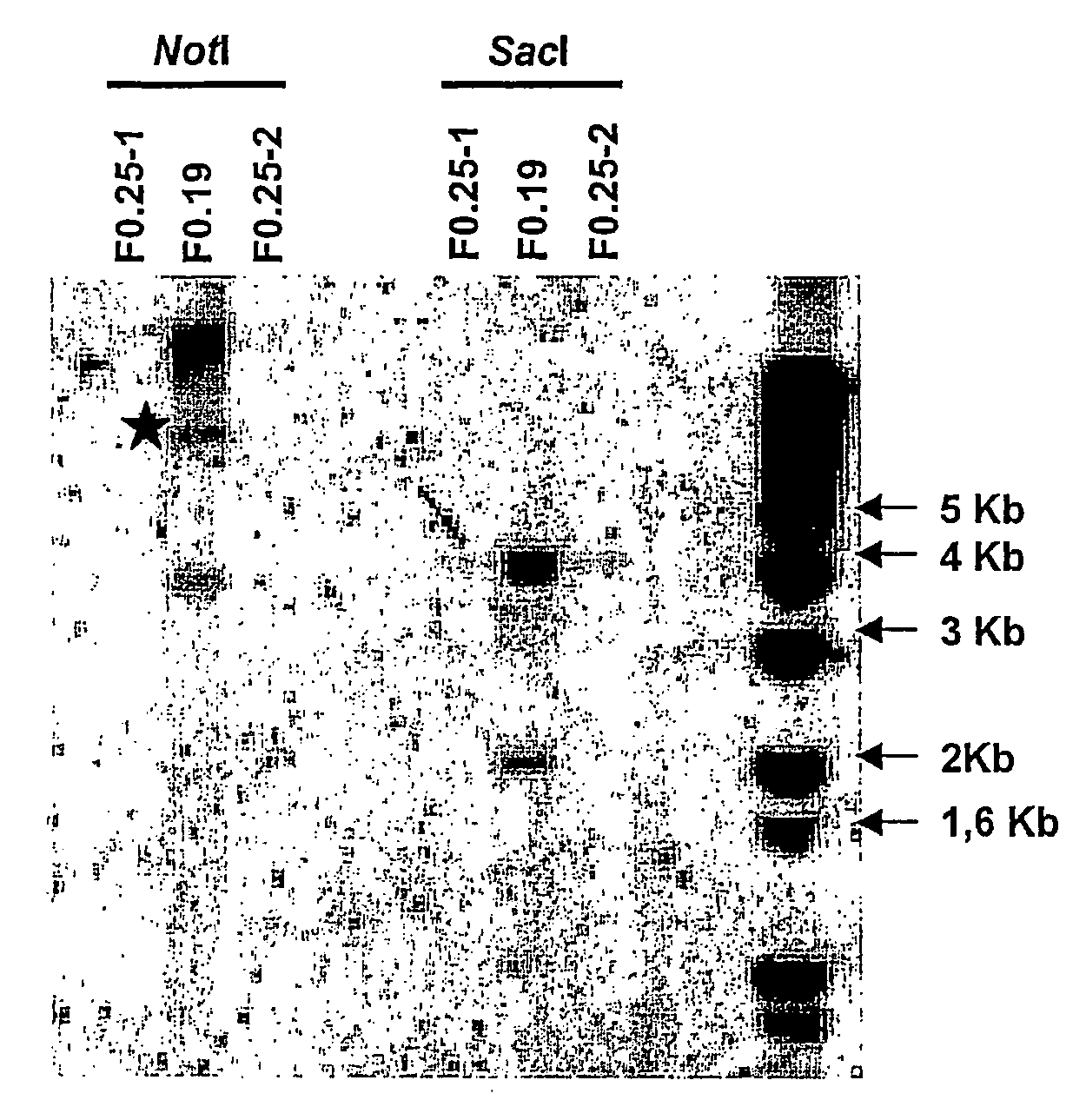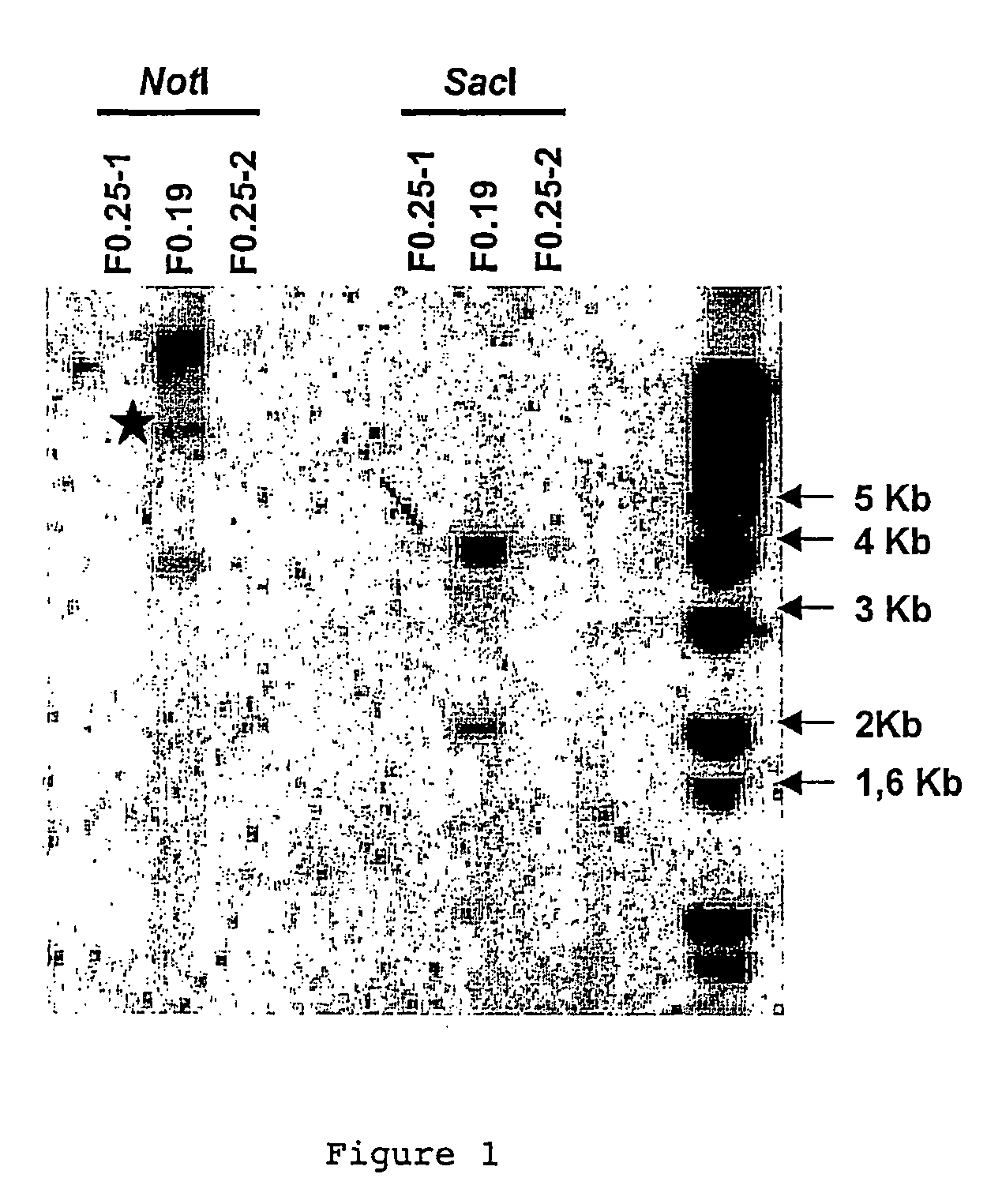In-vitro method for producing oocytes or eggs having targeted genomic modification
a technology of oocytes and eggs, applied in the field of in vitro methods, can solve the problems of limiting cell access, difficult to access the nucleus that contains the genetic material, and extremely low frequency of homologous recombination mechanisms in the majority of organisms
- Summary
- Abstract
- Description
- Claims
- Application Information
AI Technical Summary
Benefits of technology
Problems solved by technology
Method used
Image
Examples
example 1
Random Insertion of an I-SceI Site in the Medaka Genome
[0057]1) pα1TI-EGFP-I construction: The pa1TI-GFP-I construction was obtained by inserting, in the plasmid pα1TI-EGFP (Goldman et al., Transgenic Res., vol. 10(1), p: 21-33, 2001; HIEBER et al., J. Neurobiol., vol. 37(3), p: 429-440, 1998)), a recognition site for the I-SceI meganuclease between the promoter of the αI-tubulin of the zebrafish and the reporter gene of the EGFP (enhanced green fluorescent protein).
[0058]In a first step, the pα1TI-EGFP construction was digested by the enzyme BamHI (BIOLARGE) and the digested construction was then purified. The pa1TI-EGFP construction digested by BamHI was then dephosphorylised and then purified again. Finally, a ligation reaction was performed between the pα1TI-EGFP construction, digested by BamHI and dephosphorylised, and a double-strand oligonucleotide containing the site I-SceI site (in bold characters) and cohesive free ends, compatible with the digested BamHI site (sense oligo...
example 2
Targeted Insertion of a Transgene in the Genome of a Transgenic Medaka Lineage Having an I-SceI Site
[0088]1) Repair construction (RC): For the purpose of integrating a transgene in the Medaka genome in a targeted fashion, we tested a breach repair technique. For this, we used a second transgene containing the tracer gene of mRFP1 (monomeric red fluorescent protein) surrounded on each side by sequences of at least 500 bp perfectly homologous with the regions surrounding the I-SceI site of the α1TI-EGFP-I transgene (RC, Repair Construction). The homologous region at 5′ corresponds to the intronic sequence of the promoter α1TI, which thus removes any possibility of expression of the mRPF1 in episomal form.
[0089]In order to achieve this construction, the SacI-NotI fragment of the plasmid P1TI-EGFP (1.7 kb), corresponding to the homology regions situated on each side of the I-SceI site, was purified and cloned in the pCRII-TOPO® vector (Invitrogen) linearised by a SacI-NotI digestion. Th...
example 3
Targeted Insertion of a Transgene in the Genome of a Medaka Transgenic Lineage Using Other Meganucleases
[0105]Firstly random integrations are performed according to the protocol described in example 1, but with the I-CreI and I-CeuI meganucleases and constructions comprising respectively a recognition site for I-CreI meganuclease (SEQ ID NO:5: 5′-CTGGGTTCAAAACGTCGTGAGACAGTTTG G-3′) and I-CeuI (SEQ ID NO:6: 5′-CGTAACTATMCGGTCCTMGGTAGCGAA-3′) between the zebrafish α1-tubulin promoter and the EGFP reporter gene.
[0106]The constructions and the protocol used for performing the targeted insertion are the same as previously described in example 2 but using the I-CreI and I-CeuI meganucleases (NEW ENGLAND BIOLABS).
PUM
| Property | Measurement | Unit |
|---|---|---|
| Temperature | aaaaa | aaaaa |
| Temperature | aaaaa | aaaaa |
| Fraction | aaaaa | aaaaa |
Abstract
Description
Claims
Application Information
 Login to View More
Login to View More - R&D
- Intellectual Property
- Life Sciences
- Materials
- Tech Scout
- Unparalleled Data Quality
- Higher Quality Content
- 60% Fewer Hallucinations
Browse by: Latest US Patents, China's latest patents, Technical Efficacy Thesaurus, Application Domain, Technology Topic, Popular Technical Reports.
© 2025 PatSnap. All rights reserved.Legal|Privacy policy|Modern Slavery Act Transparency Statement|Sitemap|About US| Contact US: help@patsnap.com



